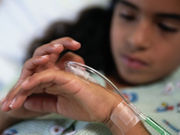About half of unanticipated admissions related to anesthesia; risk factors include age, ASA class
FRIDAY, June 10, 2016 (HealthDay News) — The incidence of pediatric unanticipated admissions is 0.97 percent, with about half of admissions related to anesthesia, according to a study published online June 1 in Pediatric Anesthesia.
Amanda Whippey, M.D., from McMaster University in Hamilton, Canada, and colleagues compared pediatric patients undergoing ambulatory surgery and requiring unanticipated admission between 2005 and 2013 with a random sample of pediatric patients not requiring admission. They collected data on demographics, surgical information, medications, intraoperative events, and patient comorbidities from both groups.
The researchers found that the incidence of unanticipated admission was 0.97 percent, and 47 percent of cases were anesthesia-related. Factors associated with unanticipated admission included age younger than 2 years (odds ratio, 4.26); American Society of Anesthesiologists (ASA) 3 class (odds ratio, 3.77); duration of surgery above one hour (odds ratio, 6.54); completion of surgery after 3 p.m. (odds ratio, 2.17); orthopedic, dental, or ear, nose, and throat (ENT) surgery (odds ratios, 2.52, 0.21, and 6.47, respectively); intraoperative events (odds ratio, 4.45); and obstructive sleep apnea (OSA; odds ratio, 6.32).
“The incidence of unanticipated admission in children following ambulatory surgery is low. Age, ASA class, duration, and time of completion of surgery are predictors common to pediatrics and adults,” the authors write. “Interestingly, intraoperative complications, OSA, and type of surgery (ENT, orthopedic, dental) are specific to pediatrics.”
Copyright © 2016 HealthDay. All rights reserved.








